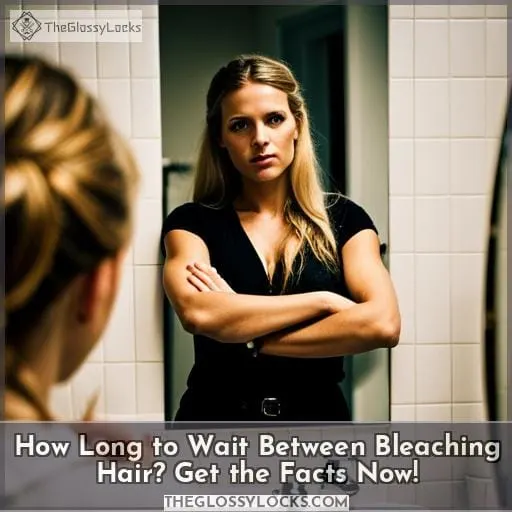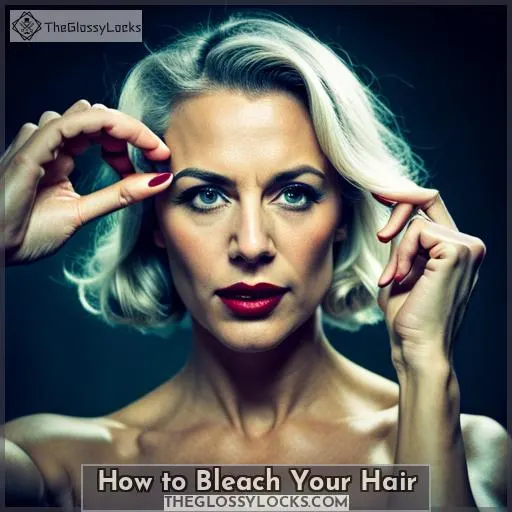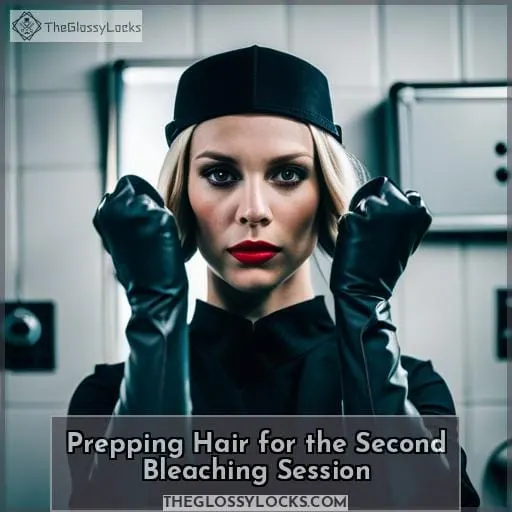This site is supported by our readers. We may earn a commission, at no cost to you, if you purchase through links.
Buckle up! We’re about to explore the intriguing world of bleaching hair and how long you should wait between sessions. The process of bleaching oxidizes melanin pigments in the hair shaft, lightening its color.
It’s a chemical reaction that calls for hydrogen peroxide and ammonia — two harsh ingredients that can cause some serious damage if used too often or without proper care.
To ensure safe and healthy results, it’s important to understand not just when but also how to bleach your hair properly.
Read on for answers!
Table Of Contents
- Key Takeaways
- What is Bleaching?
- What Are the Potential Harmful Effects of Bleaching Hair?
- How Long Should I Wait Between Bleaching Sessions?
- How to Bleach Your Hair
- Prepping Hair for the Second Bleaching Session
- Tips and Warnings
- How Much Time Should I Wait for Re-bleaching?
- Final Tips
- Frequently Asked Questions (FAQs)
- Conclusion
Key Takeaways

- It is recommended to wait at least one month between bleaching sessions to minimize hair damage.
- Pre-bleaching care, such as avoiding heat styling tools and applying coconut oil, is essential for protecting the hair.
- Regular post-bleaching care, including shampooing, conditioning, and using hydrating products, helps maintain hair elasticity and moisture.
- Exceeding 6-8 bleaching sessions per year can cause permanent hair damage, so it is important to limit the frequency of bleaching to avoid over-processing and breakage.
What is Bleaching?
Discover how you can lighten your hair with the bleaching process, without compromising its condition or risking severe damage. Bleaching is a chemical treatment that strips hair of its natural pigment so it can be colored lighter shades, such as blonde and pink.
This effect comes with some risks, including weakened strands and over-processing if not done correctly.
Double bleaching in one day should always be avoided to prevent excessive damage to the hair cuticles.
Hair care before bleaching is essential. Keep heat styling tools away from your locks and apply coconut oil liberally the night prior to soften them up for maximum lift when lifting color through bleach application.
To further protect against brassiness caused by double processing or lack of toner, use purple shampoo regularly after washing your tresses. This helps neutralize any yellow tones left behind by bleach residue on midlengths and ends post-bleach session.
Applying deep conditioning treatments also helps maintain elasticity levels during this time, as well as keeping moisture locked into each strand, aiding in overall strength retention once all coloring processes are complete.
Merging these prepping tips together creates an optimal environment where minimal breakage occurs, allowing you to achieve desired lightness faster but still safely.
Post-care includes regular shampooing, conditioning, and hydrating products like leave-ins, oils, etc., to keep both scalp skin balanced and healthy, yet replenished of necessary hydration needed following each coloring procedure due to their naturally drying effects upon contact.
Finally, since repeated exposure weakens strands, it’s important to remember that no matter what type of texture is being worked on, never exceed six to eight times within a year.
What Are the Potential Harmful Effects of Bleaching Hair?
Although bleaching your hair can give you the look you want, it also carries certain risks that could harm your tresses. This process involves using harsh chemicals like hydrogen peroxide to strip away natural pigment and lighten strands.
It’s important to be aware of the potential damage that this procedure may cause – from weakened hair cuticles to the risk of permanent breakage or over-processing if not done correctly.
To avoid such issues, follow proper techniques and prepping guidelines before bleaching, as well as during its application on each section. Start with a maximum of 6-8 times within one year due to its naturally drying effects upon contact with the scalp.
When bleaching, coconut oil should always be applied beforehand so hair softens up for maximum lift when lifting color through bleach. Purple shampoo helps neutralize any yellow tones left behind post-session. Additionally, roots must always be separated from mids & ends prior to beginning the application.
Time frames between 10 minutes, depending on the desired darkness level achieved, once all processes are complete.
How Long Should I Wait Between Bleaching Sessions?
It’s important to be mindful of the amount of time between bleaching sessions in order to protect your hair from over-processing and breakage. The general rule is waiting at least one month before re-bleaching, though this may vary depending on your hair’s health and condition.
If it’s healthy, well-moisturized, and not severely damaged, then a shorter period such as a week or two can work for a second round. However, if you’ve already experienced damage from previous lightening attempts, then professional help should be sought out for advice regarding when the next bleaching session should occur – usually six months after initial treatments are carried out.
When considering how long to wait between bleaches, prep correctly beforehand by avoiding heat styling tools, applying coconut oil overnight, and shampooing regularly with nourishing products afterwards.
Furthermore, ensure that bleach isn’t left on for too long (10 minutes max) during application, together with limiting maximum times within one year up until 6-8 sessions only per annum.
Finally, make sure not to attempt twice in one day since even small mistakes could result in permanent harm done onto individual strands without being able to recover again ever once more, unfortunately enough, sadly indeed.
How to Bleach Your Hair
Preparing for a bleaching session requires gathering the necessary materials and knowledge of how to safely proceed. To help you get started, here is a step-by-step guide on bleaching hair with coconut oil and bleach.
First things first: make sure you have all your supplies ready, such as gloves, a plastic bowl, deep conditioner, coconut oil, and bleach. Then follow our instructions carefully – from prepping the night before to post-bleaching care – so that you can achieve the desired results without risking damage.
Get the Materials Ready
Gather up all the supplies you need for bleaching – from coconut oil to deep conditioner, gloves, and a plastic bowl – so you can get ready for your hair transformation!
Before beginning this process, make sure to avoid heat styling tools and apply coconut oil on the previous night.
Wear an old t-shirt or something that won’t be ruined if bleach splatters onto it during application.
Hair care is also important after bleaching; use quality hair care products regularly, such as shampooing and conditioning with hydrating products every few days.
For safety reasons, start by applying bleach in small sections at a time, starting from the back of your head before moving forward towards roots, then mids & ends, while ensuring not leaving it on longer than 10 minutes at each part respectively.
After completing these steps, wash out with cold water immediately followed by drying off gently using a towel without rubbing too hard against strands, which could cause breakage itself already!
Keeping in mind that there are always risks when engaging in any sort of chemical processes like this one here being discussed upon now makes following best practices even more essential – no matter how many times done within a year’s period either way indeed.
Bleaching Instructions: a Step-By-Step Guide
Follow these step-by-step instructions for safely bleaching your hair at home and enjoy the transformation into a beautiful, lightened hue:
Start by prepping with coconut oil to protect your locks from overprocessing.
Gather all bleaching ingredients, such as gloves and bleach preparation.
Apply bleach starting from the back of the head, then move forward towards the roots – making sure not to leave it on longer than 10 minutes per section respectively.
After completing the steps above, immediately wash out using cold water, followed by drying off gently with a towel without rubbing too hard against strands!
Test hair elasticity regularly for the best results when done correctly; a deep conditioning treatment should be applied before and after each session to prevent damage caused due to chemical processes like this one being discussed here now!
Prepping Hair for the Second Bleaching Session
Before you begin the second bleaching session, it is important to know that your hair care routine and pre-bleaching preparation are crucial for achieving the desired results. To ensure healthy hair before bleaching again, make sure to avoid using heat styling tools and apply coconut oil the night before.
Additionally, follow up with post-bleaching care such as regular shampooing, conditioning treatments, and using hydrating products to help keep your hair in good condition.
Pre-Bleaching Care
Before bleaching your hair, take the time to properly care for it by avoiding heat styling tools and applying coconut oil. Use extra virgin coconut oil as this will nourish and protect your hair from damage during the lightening process.
Coconut oil can help restore some of its natural elasticity that may be lost due to chemical treatments such as bleach application.
Applying the night before you plan on bleaching is optimal for best results, so make sure you give yourself enough time! Additionally, using room temperature water when washing out the product helps prevent further stripping of your hair’s natural pigment, which could lead to unwanted side effects like scalp irritation or dryness if not done correctly.
The best time to re-bleach is after giving at least one month between each session.
Post-Bleaching Hair Care
After bleaching, it’s essential to give your tresses the TLC they deserve. Give them a break with regular shampooing and conditioning sessions, and don’t forget to use hydrating products that will help keep hair looking vibrant while keeping split ends at bay!
To ensure maximum color options without overprocessing or breaking strands in half, experts recommend giving at least one month between each bleaching session. Once you’ve completed the process, make sure you take extra care of your mane by using moisturizing products such as coconut oil or an expert-approved toner for much-needed hydration.
Keep track of hair elasticity; if it is too low then wait until it recovers before bleaching again – this could be up to six months depending on how severely damaged your locks are. Following a great post-bleaching hair care routine is key for achieving desired results while avoiding any further damage caused by chemical treatments found in typical bleaching kits from stores like L’Oreal Paris Feria Hyper Platinum, which can strip away natural pigment when used inappropriately.
Remember: cold water should always be used after lightening sessions – this helps close cuticles so that dye lasts longer than usual!
Tips and Warnings
Take care to heed the tips and warnings when bleaching your hair for the best results. Pre-bleaching care is essential for minimizing damage, as the harsh effects of bleach can severely weaken strands if not done correctly.
Apply coconut oil the night before to protect against breakage and keep hair in better shape. Also, avoid using heat styling tools to reduce stress on coarse hairs during processing.
Professionals recommend waiting a month between each session. However, if your hair is healthy enough, you can redo it after one week and a half. Severe damages need at least six months of recovery time before further treatments are applied.
When bleaching, start with the roots first, then move onto the mids and ends. Each section should be bleached for approximately 20 minutes, depending on the desired lightness (no more than 10 minutes for roots).
After bleaching, wash your hair with cold water immediately and then shampoo and condition regularly using hydrating products. This will help maintain natural oils within the scalp and prevent dryness or dandruff from forming.
Prevent heat styling tools usage.
Apply coconut oil pre-treatment.
Wait 1 month minimum between sessions.
Bleach starting from back/roots first.
Use only the recommended amount of bleach.
Wash out bleach quickly with cold water.
Moisturize regularly afterwards.
Hair bleaching offers many color options that cannot otherwise be easily achieved.
How Much Time Should I Wait for Re-bleaching?
It’s recommended that you give your hair at least a month to recover before re-bleaching, as repeated treatments can weaken and damage strands. Hair elasticity tests can inform you of the health of your hair, but it may be best to wait six months if severe damage has already been done.
Ideally, after effects from the first bleaching session have worn off and smaller sections are treated with coconut oil pre-treatment for hydration and protection against breakage. Waiting one month or longer between bleaches will allow enough time for recovery in order to achieve desired lightness without risking further injury.
For those hoping to go blonde or even pink, multiple sessions spaced out over an ideal amount of time are necessary in order for hair color goals to be reached safely without sacrificing quality locks along the way! Hydrating products should also be used both post and pre-bleach.
Applying some overnight on damp tresses prior helps ensure that moisture levels remain elevated during processing, while deep conditioning afterwards delivers essential nourishment back into strands right away following each session.
Though twice a month is possible when keeping up healthy habits like using hydrating products regularly and avoiding heat styling tools altogether, caution should still remain top priority.
Final Tips
For maximum hair health and color results, follow these final tips: make sure not to leave the bleach on for eternity and never attempt twice-in-one-day bleaching – that’s a recipe for disaster!
Pre-bleaching care is essential in order to achieve desired results. Apply coconut oil liberally overnight before bleaching as it helps protect strands from damage. Avoid using heat styling tools prior to coloring hair, as they can weaken already delicate locks even further.
Post-bleaching care is just as important if you want your mane looking its best after chemical treatments are done with it. Regularly shampoo and condition your hair to keep your strands clean, while hydrating products replenish lost moisture from the processing time spent under the dryer or bowl of bleach mixture itself! You may also need to apply copious amounts of toner afterwards, depending on the achieved shade.
Bleach should only ever be used once a month at most, since applying it twice within the same day period could cause severe damage due to overprocessing – regardless of how careful the treatment may seem outwardly – so patience must always remain top priority when trying out new colors or lightening existing ones permanently without sacrificing natural beauty along the way either! Proper prepping beforehand keeps everything running smoothly, while proper post-care ensures long-lasting vibrancy despite the copious amount of sessions needed sometimes to reach the goals set forth initially by the client themselves if going for lighter shades like blonde or pink, etcetera.
Frequently Asked Questions (FAQs)
What products should I use for bleaching my hair?
To achieve the desired results, use products like L’Oreal Paris Feria Hyper Platinum. It lightens hair up to 8 levels and includes an Anti-Brass conditioner with purple pigments for neutralizing brass.
Pre-bleaching care is essential; avoid using heat styling tools and apply coconut oil the night before bleaching. For post-bleaching care, shampoo regularly, deeply condition, and use hydrating products for stronger hair strands.
Is bleaching my hair a permanent change?
Yes, bleaching your hair is a permanent change. The level of lightness you achieve will depend on the number of times it has been bleached and how healthy your strands are.
Are there home remedies for bleaching my hair?
Yes! There are various home remedies you can use to help lighten your hair. Try combining chamomile tea with lemon juice and honey for a natural bleaching agent, or mix baking soda and hydrogen peroxide for an effective DIY bleach.
Be sure to do a patch test before using any of these treatments, as they may irritate the scalp if used incorrectly.
What is the best way to prepare my hair for bleaching?
Prepare your hair for bleaching by applying a nourishing oil like coconut oil the night before. Avoid using heat styling tools and use a deep conditioner to keep it hydrated. When applying bleach, start with the back of your head, then apply it to the roots separately.
Wait 20 minutes for the mids and ends, and 10 minutes for the roots. Afterward, rinse with cold water to stop the process.
How often should I bleach my hair?
Bleaching your hair can be damaging, so it’s best to limit bleaching sessions. Wait at least one month between bleachings and always keep hair healthy and moisturized. To minimize damage, follow a strict pre-bleach care routine and consult with a professional stylist before starting the process.
Conclusion
Bleaching your hair can be a great way to achieve your desired color, but it can also lead to damage if not done correctly. Following the steps outlined in this article, including pre- and post-bleaching care, using the right materials, and waiting the recommended time between bleaching sessions, can help you get the look you want without compromising the health of your hair.
Bleaching hair should not be done more than six times a year, and it’s best to consult a professional hairstylist to ensure you get the best results. With the right preparation and care, you can have beautiful color without the worry of damaging your hair.









